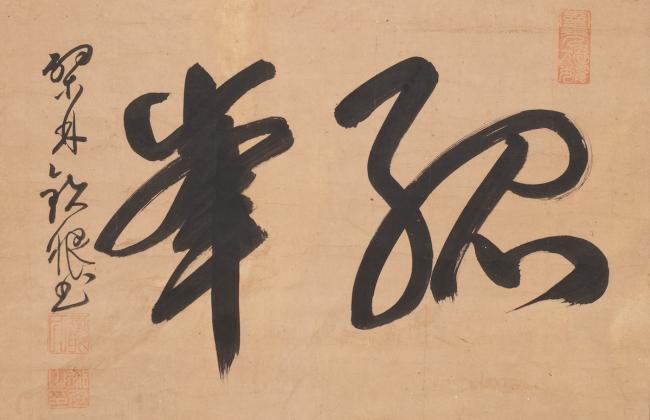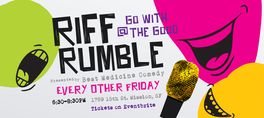Meditation in Motion: Zen Calligraphy from the Stuart Katz Collection is the first exhibition at BAMPFA to present the unique art form of Japanese Zen-inspired calligraphy. It features several important works by Chinese ?baku monks who immigrated to Japan, as well as a selection of writings by Japanese monks who followed and expanded on their examples. The exhibition is drawn from the private collection of Stuart Katz, who has made a promised gift to BAMPFA of these and many more paintings.
With the fall of the Ming dynasty in the mid-seventeenth century, monks from China's Fujian province who followed the Chan form of Buddhism left for Japan, where there was a well-established Zen Buddhist community. Their home in China was centered in Wanfusi on Huangbo Mountain; thus they were designated ?baku--the Japanese translation of Huangbo. These monks practiced a form of meditation and "finding one's true nature" that resembled that of the Zen schools of the well-established Rinzai Zen sect, but differed enough in elemental ways that they proceeded to establish a new branch of Zen Buddhism. Although Japan at the time was largely closed to the outside world, the ?baku monks were welcomed by the ruling Shogunate for their teachings and practice.
Their traditions varied in interesting and influential ways: they drank steeped tea rather than the traditional Japanese whisked tea; they maintained their practice of chanting sutras in their native Fujianese language; they wore their hair short rather than shaving their heads. Thus, they were regarded as followers of a distinct form of Japanese Zen practice until the late nineteenth-century Meiji Restoration. One of their great contributions to Japanese culture came through the art of calligraphy, in which one's inner self can be expressed and revealed through disciplined practice of the art. They brushed koans (short, paradoxical sayings) intended to be comprehended not through analysis but by sudden intuition, and wrote or copied brief texts from important teachings. Their work appeared as scrolls that would hang in temples and homes, evoking a sentiment that resounded with Japanese sensibilities.
Image Credit: Tetsugen Doko: ?baku Zen calligraphy, two large characters in cursive style, 17th century; ink on paper; 12 x 18 in., mount: 44 x 23 in.; BAMPFA, promised gift of Stuart Katz.
show less
With the fall of the Ming dynasty in the mid-seventeenth century, monks from China's Fujian province who followed the Chan form of Buddhism left for Japan, where there was a well-established Zen Buddhist community. Their home in China was centered in Wanfusi on Huangbo Mountain; thus they were designated ?baku--the Japanese translation of Huangbo. These monks practiced a form of meditation and "finding one's true nature" that resembled that of the Zen schools of the well-established Rinzai Zen sect, but differed enough in elemental ways that they proceeded to establish a new branch of Zen Buddhism. Although Japan at the time was largely closed to the outside world, the ?baku monks were welcomed by the ruling Shogunate for their teachings and practice.
Their traditions varied in interesting and influential ways: they drank steeped tea rather than the traditional Japanese whisked tea; they maintained their practice of chanting sutras in their native Fujianese language; they wore their hair short rather than shaving their heads. Thus, they were regarded as followers of a distinct form of Japanese Zen practice until the late nineteenth-century Meiji Restoration. One of their great contributions to Japanese culture came through the art of calligraphy, in which one's inner self can be expressed and revealed through disciplined practice of the art. They brushed koans (short, paradoxical sayings) intended to be comprehended not through analysis but by sudden intuition, and wrote or copied brief texts from important teachings. Their work appeared as scrolls that would hang in temples and homes, evoking a sentiment that resounded with Japanese sensibilities.
Image Credit: Tetsugen Doko: ?baku Zen calligraphy, two large characters in cursive style, 17th century; ink on paper; 12 x 18 in., mount: 44 x 23 in.; BAMPFA, promised gift of Stuart Katz.
Meditation in Motion: Zen Calligraphy from the Stuart Katz Collection is the first exhibition at BAMPFA to present the unique art form of Japanese Zen-inspired calligraphy. It features several important works by Chinese ?baku monks who immigrated to Japan, as well as a selection of writings by Japanese monks who followed and expanded on their examples. The exhibition is drawn from the private collection of Stuart Katz, who has made a promised gift to BAMPFA of these and many more paintings.
With the fall of the Ming dynasty in the mid-seventeenth century, monks from China's Fujian province who followed the Chan form of Buddhism left for Japan, where there was a well-established Zen Buddhist community. Their home in China was centered in Wanfusi on Huangbo Mountain; thus they were designated ?baku--the Japanese translation of Huangbo. These monks practiced a form of meditation and "finding one's true nature" that resembled that of the Zen schools of the well-established Rinzai Zen sect, but differed enough in elemental ways that they proceeded to establish a new branch of Zen Buddhism. Although Japan at the time was largely closed to the outside world, the ?baku monks were welcomed by the ruling Shogunate for their teachings and practice.
Their traditions varied in interesting and influential ways: they drank steeped tea rather than the traditional Japanese whisked tea; they maintained their practice of chanting sutras in their native Fujianese language; they wore their hair short rather than shaving their heads. Thus, they were regarded as followers of a distinct form of Japanese Zen practice until the late nineteenth-century Meiji Restoration. One of their great contributions to Japanese culture came through the art of calligraphy, in which one's inner self can be expressed and revealed through disciplined practice of the art. They brushed koans (short, paradoxical sayings) intended to be comprehended not through analysis but by sudden intuition, and wrote or copied brief texts from important teachings. Their work appeared as scrolls that would hang in temples and homes, evoking a sentiment that resounded with Japanese sensibilities.
Image Credit: Tetsugen Doko: ?baku Zen calligraphy, two large characters in cursive style, 17th century; ink on paper; 12 x 18 in., mount: 44 x 23 in.; BAMPFA, promised gift of Stuart Katz.
read more
With the fall of the Ming dynasty in the mid-seventeenth century, monks from China's Fujian province who followed the Chan form of Buddhism left for Japan, where there was a well-established Zen Buddhist community. Their home in China was centered in Wanfusi on Huangbo Mountain; thus they were designated ?baku--the Japanese translation of Huangbo. These monks practiced a form of meditation and "finding one's true nature" that resembled that of the Zen schools of the well-established Rinzai Zen sect, but differed enough in elemental ways that they proceeded to establish a new branch of Zen Buddhism. Although Japan at the time was largely closed to the outside world, the ?baku monks were welcomed by the ruling Shogunate for their teachings and practice.
Their traditions varied in interesting and influential ways: they drank steeped tea rather than the traditional Japanese whisked tea; they maintained their practice of chanting sutras in their native Fujianese language; they wore their hair short rather than shaving their heads. Thus, they were regarded as followers of a distinct form of Japanese Zen practice until the late nineteenth-century Meiji Restoration. One of their great contributions to Japanese culture came through the art of calligraphy, in which one's inner self can be expressed and revealed through disciplined practice of the art. They brushed koans (short, paradoxical sayings) intended to be comprehended not through analysis but by sudden intuition, and wrote or copied brief texts from important teachings. Their work appeared as scrolls that would hang in temples and homes, evoking a sentiment that resounded with Japanese sensibilities.
Image Credit: Tetsugen Doko: ?baku Zen calligraphy, two large characters in cursive style, 17th century; ink on paper; 12 x 18 in., mount: 44 x 23 in.; BAMPFA, promised gift of Stuart Katz.
show less
Date/Times:
Berkeley Art Museum and Pacific Film Archive (BAMPFA)
25 Upcoming Events
2155 Center Street, Berkeley, CA 94720
The Best Events
Every Week in Your Inbox
From Our Sponsors
UPCOMING EVENTS
Great suggestion! We'll be in touch.
Event reviewed successfully.









